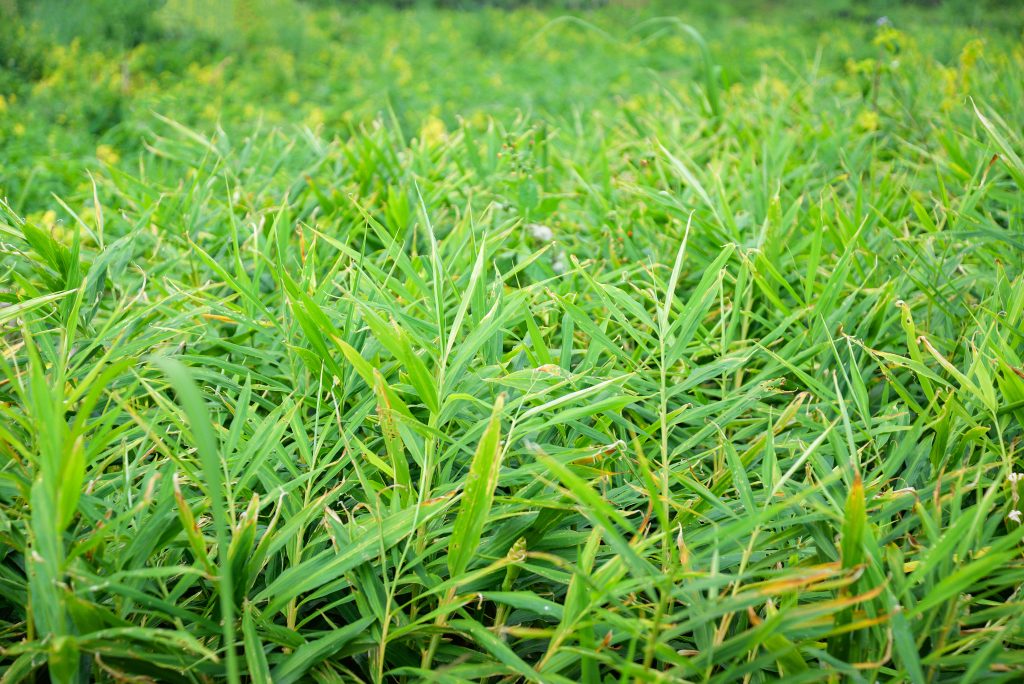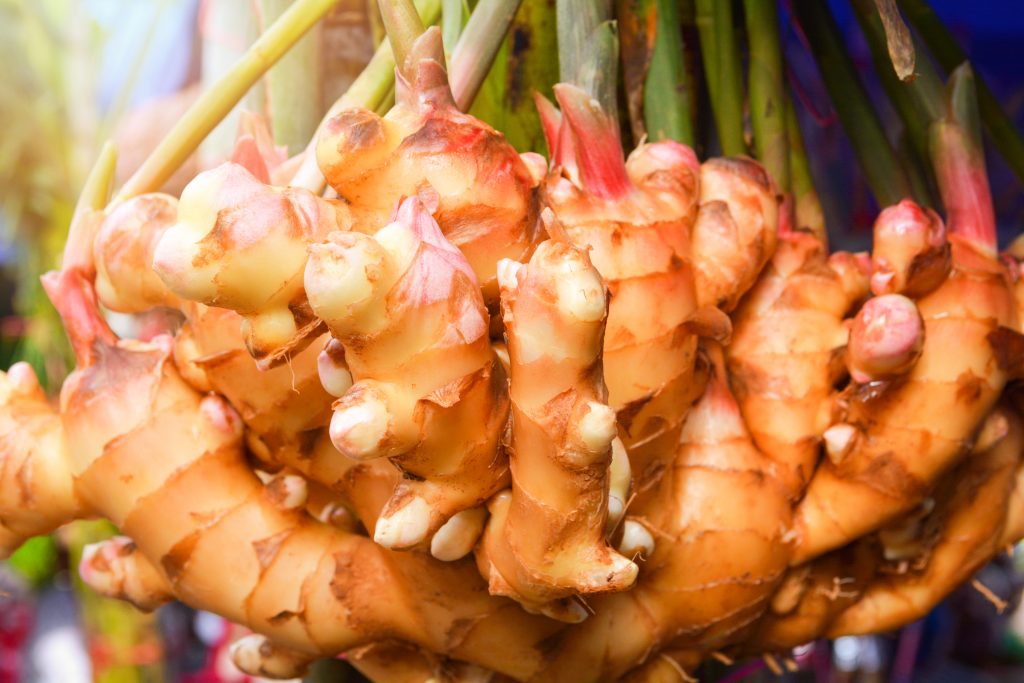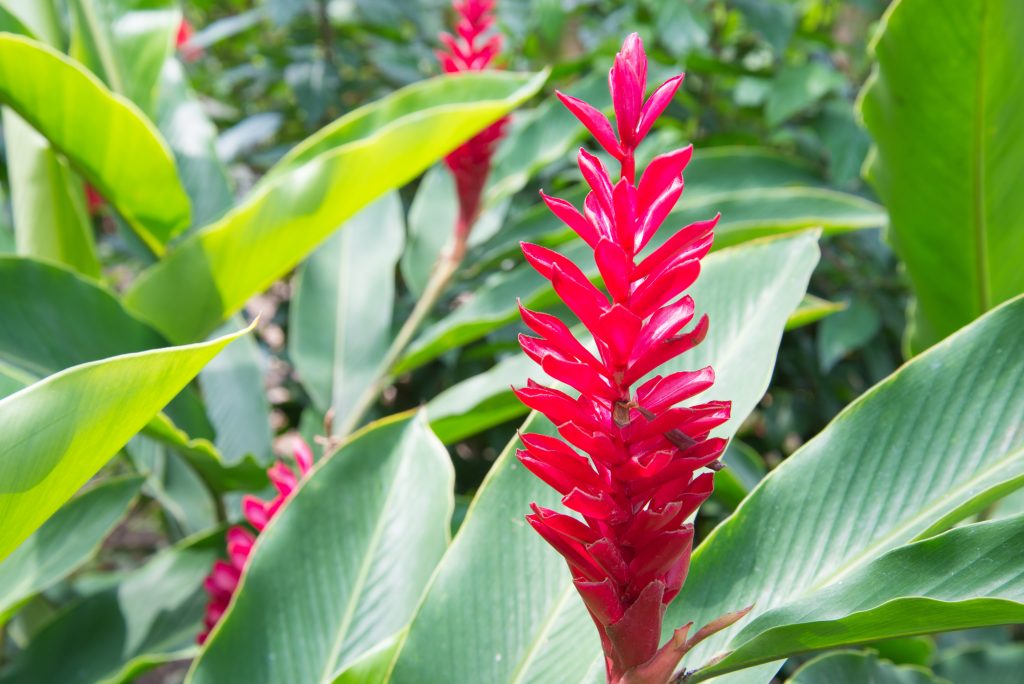The name Ginger stems from the Sanskrit word “shringan” meaning “horn of a dear”. It refers to the special form of the Ginger rhizomes which have been used in Asian cooking and medicine over thousands of years. Ginger has abundantly been used since old in the Ayurvedic kitchen of India. Confuzius has already praised the virtues of Ginger in China long before the Christian era. In the middle ages Ginger was used for brewing beer and as a spice in certain dishes for the more prosperous people. It is definitely known to the Western world since at least 2 000 years. After the discovery of the Americas Ginger was introduced to Latin American and later to African countries where it is cultivated today to a large extent. The major producing countries of Ginger oil today are India, Sri Lanka, China, and Indonesia.
Ginger roots contain between 1 – 3 % of essential oil, the yield depending on the geographical source of the raw material. The oil is obtained by steam distillation, including cohobation, of the freshly ground, usually unpeeled rhizomes. They contain the major active ingredients responsable for Ginger’s taste and odour profile. But this noble essential oil is far less “hot” or pungent than the Ginger root or rhizome itself. During the long hours of distillation (10-24 hours) the raw material looses most of its “firy” components (e.g. a phenolic substance called gingerol), yielding an oil high in sesquiterpenes (zinziberene, beta-bisabolene, beta-farnesene…). These substances are known in modern aromatherapy for their capacity to help creating a more balanced inner awareness and a greater tranquility of the mind.
Where does the oil act?
Despite its relative mildness Ginger oil is nevertheless a good carminative and excellent to help against constipation, diarrhoea, intestinal cramps, including menstrual cramps, and flatulence. Several studies have shown that Ginger tones the digestive tract and the intestinal muscles thereby easing transport and protecting the intestines against irritation. It also may protect the stomach from the damaging effect of alcohol. Single or together with Cinnamon oil it is a good ally against travel or motion sickness and nausea. The Lancet, a well respected British scientific magazine, reports that “The powdered rhizome of Zingiber officinale has been found to be more effective than dimenhydrinate (Dramamine) in reducing motion sickness in individuals highly susceptible to this malady (Mowrey/Clayson, The Lancet, 1982).” This is also valid for the essential oil.
Recent studies have furthermore revealed that Ginger is efficient in inhibiting the formation of certain carcinogens (both chemical carcinogens and mutagens). And, also important: Ginger oil has also been found to have beneficial effects against human coronary diseases. It reduces platelets formation due to its capacity to make the blood less sticky and less capable to aggregate. That means: Ginger is good for high blood pressure. And, very important, research shows that it is also a good remedy in cases of problems of the respiratory tract including bronchitis, coughs, catarrh, flu, sinusitis.
And not to forget: The beneficial actions of ginger oil on rheumatism, arthritis and muscular pains are well documented. Dr. D. Baudoux, pharmacist from Belgium, mentions Ginger oil as tonifier in case of sexual asthenia and as a good remedy to treat anexoria. He also mentions its interesting anti-inflammatory effects (arthritis, rheumatism) and its virtue to enhance senstitiviy in case of “cerebral asthenia”. (D. Baudoux, L’Aromathérapie, p. 146-147). As an ingredient in a massage oil, often in combination with other essential oils such as Wintergreen, Peppermint etc. Ginger oil helps against headaches, migraines, and muscular or schiatic pains.
In Ayurveda Ginger is considered a rejuvenator or “rasayana” having beneficial effects on all “dhatus” (tissue-elements) of the body. It was called in ancient times “the universal medicine” (vishvabhesaj) and is “perhaps the best and most sattvic of all spices” (Vaidya Vasant Lad, The Yoga of Herbs, p. 122). Also in Ayurveda Ginger is used in case of respiratory and digestive and diseases and also considered efficient for arthritic problems – and a good toner for the heart. It is an excellent helper against nervous exhaustion and a major revitalizer and detoxifier that gently kindles the digestive fire put under strain through bad food, stress and exaggerated traveling. The so called “Trikatu”, a curative Ayurvedic spice mix is a blend of Ginger, black Pepper, and long Pepper. It is famous in Ayurveda, because it is the most effective combination of spices to prevent “ama” (toxins) and encourage “amavisha” (detoxification), thereby also helping the system to maintain a healthy immunity against “foreign invaders”. 🙂


Manifold more usages
Ginger oil is well accepted by most skin types. Although a warming oil, it is not dermocaustic. Studies on the safety of it have shown that 4 % of it diluted in a carrier oil do not create any skin irritation. Ginger oil is also good against skin impurities. It “has a soothing and mild effect on skin and soul, and when applied to the solar (soular 🙂 ) plexus, it gives inner comfort and psychological warmth which directly ‘rises from the belly’ “ (Ruth von Braunschweig, German naturopath).
In modern perfumery Ginger oil is used particularly for oriental notes for men and women. It is considered to enrich a perfume or a Cologne creating warmer, spicy-woody-green fragrances together with clear fresh-lemony head notes on a soft-sensual background. It is also used for flavouring soft drinks (Ginger Ale), and for aromatizing cookies, puddings, chocolates etc.
Synergy of Heaven and Earth
In Ginger the process of creation of essential oils, normally happening on the higher plant centers like blossoms, seeds, fruits – the “Sulfur” level in Alchemy – or from there descending to the leaves – the “Mercurius” level in Alchemy – has penetrated the deeper energy centers of the plant resulting in a plant that “blossoms from its roots” – the “Sal” level in Alchemy. This is very special and happens quite rarely in the evolution of aromatic substances that a plant becomes “spicy” and fragrant from its roots, the area of the mineral world, the world of cold and dark, wanting to escape the light of the Sun by all means. So Ginger becomes a spice through the mystery of its we can call it “back-shot dynamics”; I want to say with this: First it rises towards the sun with the outer vegetal push, but hides with the root from the light as much as possible. And then – here in the case of Ginger – it drives the light back down into the Earth and …creates aromas, spices, fragrances. Well, the red blossom of true Ginger had already something “in mind”. 🙂
Let us not forget: Spices are the prerogative of healthy food for man. All animals refuse spicy food. Only man wants it, sometimes abundantly. And he knows why…. Spiritually we can say that spices were created for man. Being the result par excellence of the warming influence of sun light on the plant and of its absorption of thermic energies it is not wrong to say that spices light up the inner sun in man, his “Atma”, on the level of his basic metabolic functioning. Spices induce into the human physical organism the ordering waves of energy-light-awareness allowing us to become more conscious, more endowed with the radiance of the higher Self on the basic levels of our physical existence where matter is transformed into energy and energy is transformed into matter. And from here the spices exert their curative power by letting the inner AGNI (fire) do the trick. We can say in general: it is through the hot (and also the bitter) elements in Nature that most of the healing of our problems are accomplished – with the help of our allies from the Kingdom of plants.
Ginger warms the human energy centers and gives vitality to the physiology, especially to those suffering from sun-deprivation during the long cold winter months in the Northern or extreme Southern hemisphere. And it is mostly during this period that the heavier bacterial and viral infections appear in the world. No wonder that the Western cultures of the Northern hemisphere received the spices from the Southern oriental cultures with such enthusiam and culinary creativity over so many centuries in the past.
Some research examples
“Fresh ginger (Zingiber officinale) has anti-viral activity against human respiratory syncytial virus in human respiratory tract cell lines.”
Ethnopharmacological relevance
Ginger, Zingiber officinale Roscoe, is a common spice and also a widely used medicinal plant in ancient China. Ginger is an ingredient of Ge-Gen-Tang (Kakkon-to; GGT). GGT has been proved to have antiviral activity against human respiratory syncytial virus (HRSV). However, it is unknown whether ginger is effective against HRSV.
https://doi.org/10.1016/j.jep.2012.10.043
“The active components of essential oils might consist of lipophilic carbohydrates that interact with the lipid membrane (18). These antibacterially active substances (7, 11) might exhibit similar activities against viral envelopes.”
https://aac.asm.org/content/51/5/1859.full
“Both fresh and dry ginger oils contained zingiberene as the major compound but in different ratios. The GC?MS analysis showed that fresh ginger was more abundant in oxygenated compounds. The significant antimicrobial activity of the fresh ginger oil can be attributed to this. Fresh ginger oil had an MIC value of <1 ?g/mL against Aspergillus niger and Candida albicans and. dry ginger oil had an MIC value of less than 1 ?g/mL against Pseudomonas aeruginosa , Pencillium spp and Candida albicans and The study elucidates that the dry ginger oil and fresh ginger oil can be used against these organisms.”
http://naturalingredient.org/wp/wp-content/uploads/235.pdf
“Essential oils obtained from the rhizomes of normal and organic ginger plants (Zingiber officinale Roscoe) were characterized by GC and GC?MS. Zingiberene was the chief compound in both ginger oils. Organic ginger oil contained geranial (10.5%) as the second main compound and had more oxygenated compounds (35.1%) compared to normal ginger oil (31.9%). The organic ginger oil also contained ??bisabolene (6.1%), arcurcumene (5.8%), sesquiphellandrene (2.6%) and ??cadinene (2.2%).
Antimicrobial activity of both the extracted oils was assessed against Bacillus subtilis, Pseudomonas aeruginosa, Stephylococcus aureus, E. coli, Klebsiella pneumonia, Shigella flexneri, Candida albicans, Fusarium oxysporum, Aspergillus niger, Penicillium sp by disc diffusion method and obtained results are comparable with the reference compounds. The MIC values of the oils ranged from 20µg/mL to 1 µg/mL which is very significant. The study shows a wide application of oil extracted from organic ginger in the treatment of many bacterial and fungal diseases.”
http://citeseerx.ist.psu.edu/viewdoc/summary?doi=10.1.1.403.2067
“A mixture of Ginger, Rosemary, Juniper and Lavender oil is used effectively against osteoporosis, arthritis and broken bones”
Dr. Jean Valnets, classic „Aromathérapie“
To conclude
Ginger is a marvellous gift of Nature resulting from the intrinsic harmony of Sun and Earth, here physically represented by the Ginger with its roots swollen with revitalizing heat maintained in balance by the cool and soft surrounding soil. The vibrations of light and warmth of the Sun successfully reach deep into the plant and shown that a cool soil is not a hindrance for a hot “energy shot” deep down through the plant with the help of its mysterious alchemy. We can truly say by thinking of an anthroposophic image of Rudolf Steiner: In the Ginger rhizome the root starts to blossom.
Soothening hand of Mother Earth kindled under endless fires of tropical suns.
